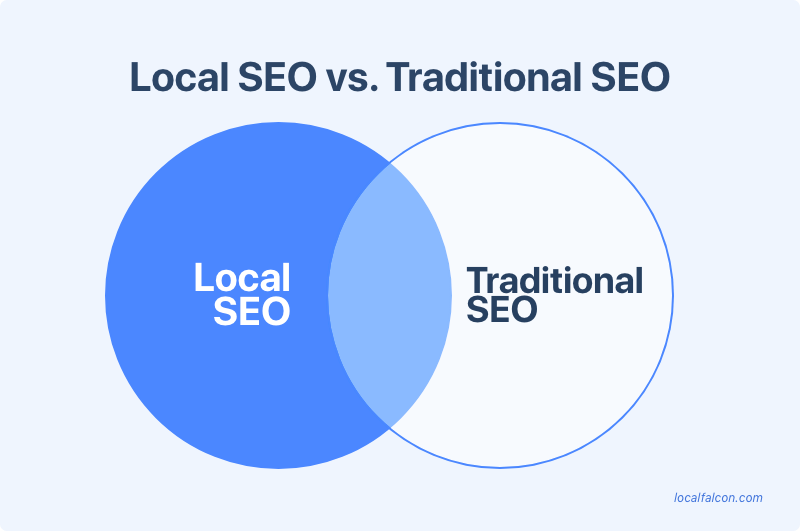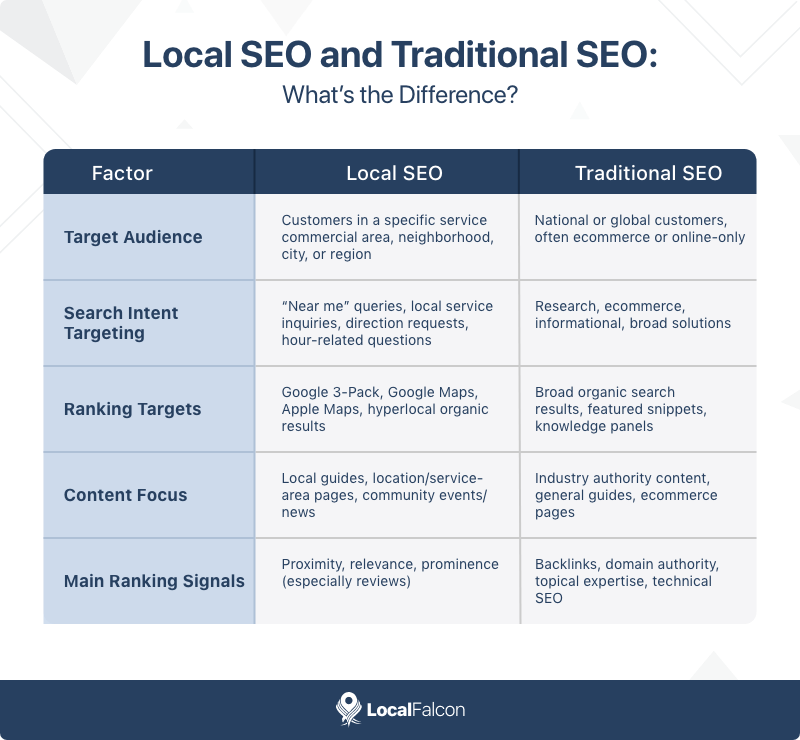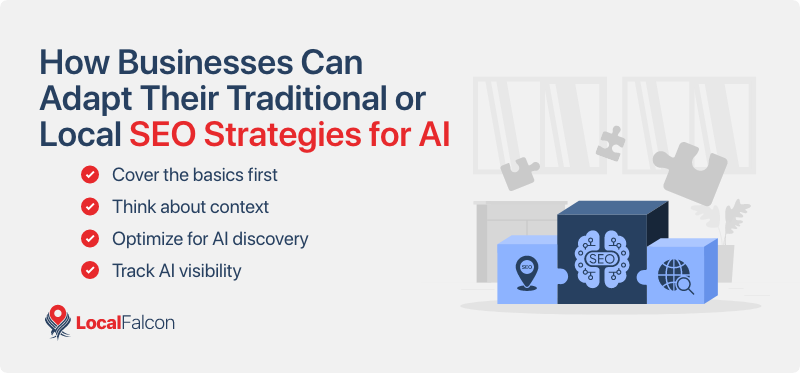Search engine optimization has always been about improving visibility and driving more business. But the conversation isn't just about "ranking on Google" anymore. With AI-powered search and conversational platforms increasingly influencing how people discover brands, businesses are rethinking how they approach local SEO and traditional SEO alike.
Both strategies share the same ultimate goal of getting your business found by the right people at the right time. Yet the tactics, scope, and outcomes differ depending on whether you're competing in local markets or targeting a broader online audience. And now, a third layer has emerged: AI visibility, or your ability to be recommended by AI search assistants like Google's AI Overviews, ChatGPT, Gemini, AI Mode, or Grok.
Let's break down the key similarities and differences between local vs traditional SEO, and explore how AI is reshaping both areas of search engine optimization.

The Basics: Local SEO vs. Traditional SEO
At their core, both local SEO and traditional SEO seek to:
- Improve rankings in search engine results.
- Drive qualified traffic.
- Increase visibility and trust.
- Convert online attention into real-world business results.
But while the goal is the same, the audience and methods shift depending on which strategy you focus on.
Local SEO: Key Characteristics
- Designed for businesses that serve a specific geographic area (restaurants, dentists, plumbers, law firms, retailers, etc.).
- Optimizes for "near me"-style searches and local-intent keywords (e.g., "coffee shop in Brooklyn" or "emergency plumber near me").
- Core elements include:
- Google Business Profile (GBP) optimization
- Local citations (business listings in directories)
- Online reviews and ratings
- Local content targeting service areas, neighborhoods, or cities
- Map pack rankings (the "3-Pack" of Google Maps results at the top of Google + results in the Google Maps app)
Traditional SEO: Key Characteristics
- Designed for businesses that serve broader, often non-geographically-specific audiences (ecommerce brands, SaaS companies, national publishers, etc.).
- Optimizes for informational and transactional queries that aren't tied to a specific location (e.g., "best project management software" or "buy running shoes online").
- Core elements include:
- On-page optimization (titles, headers, content quality)
- Technical SEO (site speed, crawlability, schema markup)
- Backlink building and digital PR
- Content marketing for national or global audiences
Local SEO vs. Traditional SEO: Where They Overlap
Even though traditional SEO and local SEO have different emphases, many tactics apply to both:
- Keyword optimization: You still need to target what people are searching for, just with a different lens (local modifiers vs. broad terms).
- On-page SEO: High-quality content, optimized meta tags, and user experience matter regardless of geography.
- Link building: Authority and credibility come from reputable backlinks, whether local media outlets or industry-leading websites.
- Mobile optimization: Most local searches happen on phones, and most traditional searches cross devices, so mobile speed and usability remain universal ranking factors.
Side-by-Side Comparison of Local and Traditional SEO
Here's a table to help you put the differences between traditional and local SEO in perspective:

Traditional SEO vs. Local SEO and AI Visibility
Here's where things get interesting. Beyond traditional search rankings, businesses now need to optimize for AI visibility.
AI-driven platforms, like Google's AI Overviews, AI Mode, ChatGPT, Gemini, and Grok, are surfacing summarized answers, recommendations, and brand mentions in response to user questions. This changes the game for both local and traditional SEO.
Local SEO and AI Visibility
For local businesses, AI visibility means:
- Being recommended in AI-generated local business lists ("best pizza in Boston," "top lawyers near me").
- Earning brand mentions in AI responses when people ask for neighborhood or city-specific suggestions.
- Getting pulled into AI-powered maps or directory features that combine business info with conversational recommendations.
This requires strong GBP optimization, consistent and relevant local citations, and a steady stream of positive reviews and mentions that AI models can interpret as trust signals.
Traditional SEO and AI Visibility
For broader brands, AI visibility takes a slightly different form:
- Being cited in product or service recommendations for ecommerce (e.g., "best running shoes," "top project management software").
- Appearing as a credible source in informational queries (e.g., "what is the best way to invest in 2025?").
- Gaining recognition as a thought leader contributing to AI responses when they synthesize content from trusted publishers.
This makes brand authority and content depth even more important. AI models prioritize information from widely-recognized sources, so businesses that have invested in building digital PR and topical expertise are more likely to be mentioned.
How Businesses Can Adapt Their Traditional or Local SEO Strategies for AI
Regardless of whether you're doing local SEO, traditional SEO, or both, adapting your search engine optimization tactics to optimize for AI search is critical. Depending on what type of business you're optimizing, elements of both strategies can fit together to maximize brand exposure in AI-generated search results.

1. Cover the Basics First
Make sure your site is technically sound, your GBP is complete (for local businesses), and your content closely matches the intent of your target audience.
2. Think About Context
- Local business? Emphasize reviews, citations, and service-area content.
- National brand? Focus on backlinks, content authority, and ecommerce optimization.
3. Optimize for AI Discovery
- Build brand mentions in authoritative sources (local news, niche blogs, industry press).
- Encourage customers to leave detailed reviews, as AI tools often pull directly from this language.
- Create content designed for AI summarization: concise answers, structured data, and FAQ-rich pages.
4. Track AI Visibility
Just as you'd track organic rankings or Google Business Profile performance, you now need to measure how often your brand appears in AI responses. Tools like Local Falcon's AI search visibility tracking are emerging to help businesses quantify this.
FAQs About Traditional vs. Local SEO
1. How can I improve my business's local SEO?
Start by optimizing your Google Business Profile, building consistent local citations across relevant directories, and asking customers for reviews. Create content that highlights your services in specific neighborhoods or cities.
2. Is local SEO more effective than traditional SEO?
It depends on your business model. If you rely on customers within a specific geographic area, local SEO is more effective. If you sell online nationally or globally, traditional SEO may deliver better results.
3. Do I need both local and traditional SEO?
Many businesses benefit from a mix. For instance, a local retailer might need local SEO to drive foot traffic while also investing in traditional SEO for ecommerce sales at the national or international level.
4. How does AI affect SEO today?
AI-powered search tools can recommend businesses, products, or brands directly in conversational results, as well as cite them as sources of information. This means your visibility isn't just about Google rankings anymore, but also about being trusted enough to be mentioned or cited by AI.
5. What's the biggest mistake businesses make with local SEO?
Neglecting reviews and inconsistent business information. If your Name, Address, and Phone Number (NAP) don't match across directories, or if you have too few recent reviews, you'll struggle to compete with brands that have polished listings and a steady stream of positive reviews.
Final Thoughts
When it comes down to it, understanding local SEO vs. traditional SEO isn't really about knowing which is better. It's about choosing the right focus based on your goals. And now, layering in strategies for AI visibility is crucial.
- If you're optimizing a brick-and-mortar or service-area business, local SEO should be your foundation.
- If you're optimizing an ecommerce or national brand, traditional SEO should take the lead.
- For everyone, AI visibility is the emerging frontier, offering a chance to gain additional exposure wherever potential customers are searching.
Ultimately, the businesses that win in the AI era will be the ones that treat the different types of SEO not as competing strategies, but rather as an integrated approach that prepares them for the AI-driven future of search.


